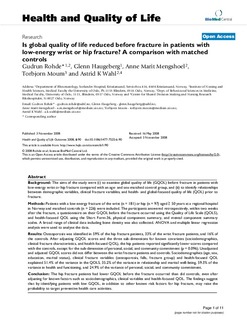| dc.description.abstract | Background: The aims of the study were (i) to examine global quality of life (GQOL) before fracture in patients with
low-energy wrist or hip fracture compared with an age- and sex-matched control group, and (ii) to identify relationships
between demographic variables, clinical fracture variables, and health- and global-focused quality of life (QOL) prior to
fracture.
Methods: Patients with a low-energy fracture of the wrist (n = 181) or hip (n = 97) aged ≥ 50 years at a regional hospital
in Norway and matched controls (n = 226) were included. The participants answered retrospectively, within two weeks
after the fracture, a questionnaire on their GQOL before the fracture occurred using the Quality of Life Scale (QOLS),
and health-focused QOL using the Short Form-36, physical component summary, and mental component summary
scales. A broad range of clinical data including bone density was also collected. ANOVA and multiple linear regression
analysis were used to analyse the data.
Results: Osteoporosis was identified in 59% of the hip fracture patients, 33% of the wrist fracture patients, and 16% of
the controls. After adjusting GQOL scores and the three sub-dimensions for known covariates (sociodemographics,
clinical fracture characteristics, and health-focused QOL), the hip patients reported significantly lower scores compared
with the controls, except for the sub-dimension of personal, social, and community commitment (p = 0.096). Unadjusted
and adjusted GQOL scores did not differ between the wrist fracture patients and controls. Sociodemographics (age, sex,
education, marital status), clinical fracture variables (osteoporosis, falls, fracture group) and health-focused QOL
explained 51.4% of the variance in the QOLS, 35.2% of the variance in relationship and marital well-being, 59.3% of the
variance in health and functioning, and 24.9% of the variance of personal, social, and community commitment.
Conclusion: The hip fracture patients had lower GQOL before the fracture occurred than did controls, even after
adjusting for known factors such as sociodemographics, clinical variables and health-focused QOL. The findings suggest
that by identifying patients with low GQOL, in addition to other known risk factors for hip fracture, may raise the
probability to target preventive health care activities. | nb_NO |
